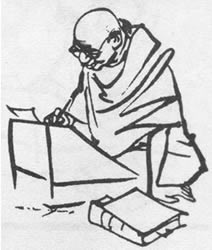
P.O. SEVAGRAM, DIST.WARDHA 442102, MS, INDIA. Phone: 91-7152-284753
FOUNDED BY MAHATMA GANDHI IN 1936
GANDHI RESOURCES: Gandhi Centers And Institutions
A List of Gandhi Institutions and Centers in India and Abroad

GANDHI RESOURCES
Resource Persons
Gandhi Centers
External Links
- Mahatma Gandhi Canadian Foundation for World Peace (Canada)
- Gandhi Information Center (Germany)
- UNC Mahatma Gandhi Fellowship (Univ. of North Carolina, Chapel Hill)
- For More Addresses...
Banwasi Seva Ashram
The Ashram, situated in Uttar Pradesh is an outstanding example of a Gandhian voluntary organization, which has realised Gandhi's vision of a self-sufficient village. The work done by the Banwasi Seva Ashram in Sonbhadra in Uttar Pradesh, India shows that antodaya i.e attention to the poorest of the poor is the pathway to sarvodaya (Welfare of all). The Gram Swaraj movement promoted by Gandhiji and by Vinoba Bhave provided the framework for the programmes of the Ashram.
Mahatma Gandhi's vision of an ideal village was: " A complete republic independent of its neighbours for its vital wants and yet interdependent for any wants in which dependence is a necessity." Mahatma Gandhi would be proud of the Banwasi Seva Ashram. His vision of enlightened confident and self-sufficient villagers running their own lives has become a reality. Wastelands have become fertile oases; water flows freely in once arid, drought prone wastes.
The Banwasi Seva Ashram is an outstanding example of a Gandhian voluntary organization (NGO). There are some 700 such social action groups throughout the length and breadth of India. Their aim is to establish a social order based on harmony, non-exploitation and decentralization and to put into practice Gandhi's conviction that village self-sufficiency is vital for the country's development. The Ashram was set up in 1954 in one of the most impoverished and least developed regions of India: the remote district of Sonbhadra in the North Indian State of Uttar Pradesh. The objective was to focus on the predominantly tribal population of this densely populated state of around 140 million people (1991 census). The Ashram's initial activities focussed on providing relief to the victims of the drought which had hit Sonbhadra in 1952. Afterwards the Ashram began organizing development programmes to help resettle the drought victims, such as the sinking of wells, village sanitation, the establishment of a few schools and various cottage industries.
The Ashram has been more successful than most in realizing Mahatma Gandhi's dream of empowering India's rural poor. With a full time staff of 247, the ashram's complex itself has become a small self-sufficient village with shops, schools, hostels, a clinic, post office, bank, demonstration farm, library, workshops and vocational training centre. More than half the staff are local people, some of whom are working in the field at fifteen sub-centres which are responsible for a cluster of 20 to 30 villages. The villagers cooperate and share life with each other, convinced that the welfare of every individual is the concern of all. They have developed self-confidence, courage, an awareness of their rights, a thirst for knowledge and an indomitable spirit. But it has been a uphill struggle for all concerned - a struggle that continues to this day. Dr. Ragini Prem, who favours a group leadership, heads the Ashram now.
Source: The Banwasi Seva Ashram by Elizabeth Hoddy
For more information contact:
Govindpur (via Turra),
Sonbhadra - 231 221,
U.P,
India
Tel. No.: 05447-85224